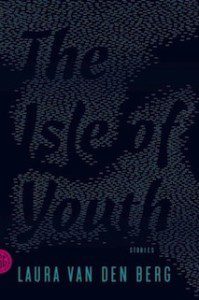
Laura van den Berg’s The Isle of Youth is a collection of seven substantial and engaging short stories that display a vivid spectrum of malaise, from the honeymoon story to the detective story to the bank robber story to the midlife crisis story to the personal apocalypse story to the coming-of-age story, and finally a tale that with Shakespearean flair switches a pair of identical twins.
The stories move through many settings and center around different characters, but all unsettle the reader with a sense that in this world things are just not quite right, and never will be. Love will never be real. People who disappear will never return, and the answers will never be found. Our siblings will betray us, and worse, we will betray them. Our fantasies will turn out, upon becoming real, to be just that: real, and therefore disappointing. We will lose everyone we failed to love and then we will lose ourselves.
Pervasive malaise aside, what is most notable about all of these stories is how confidently the author dances with conventional plotting but denies the readers’ expectations of conventional plots. Conventional mysteries are established, but they are most decidedly not solved, as in “Opa-Locka,” where our narrator, a private detective, observes a man walking into a building but never coming out. Or in “The Isle of Youth,” where the narrator’s identical twin sister has gotten mixed up in something—but what? And what will come of it? The persistent lack of resolution implies that answers don’t matter: these stories aren’t about solving mysteries, although they may remind us that the world is full of mysteries we can never solve.
Likewise, interpersonal conflicts are left without a hint at what might happen next—or they are left with the sense that they will continue on in their mildly unpleasant way. In “I Looked For You, I Called Your Name,” the narrator/protagonist is on her honeymoon, but the plane to Patagonia crash lands, and though everyone survives, during the landing her husband accidentally elbows her in the nose. As their otherwise ordinary honeymoon vacation goes on, the banality of her injury seems to stand in for the lack of drama and passion in their lives. Does she even love him? Is love even possible? Is disaster the best one can hope for? And during that disaster will you simply be marking time with your dull, day-to-day tasks?

Even images that could be interpreted by a more hopeful reader as “change” have their wings purposefully clipped in these stories, as when the narrator of “Acrobat” (a woman who missed her husband’s breakup speech because she was distracted by a group of street performers, who then spends the day trailing the street performers around Paris and ultimately is invited to an “acrobat party” disguised as one of them), is lifted into the air above the Seine to observe the world around her: the gray wall, the flashing red light of a passing airplane. Rather than allow the optimists among us to feel any “lift” from even this tepid moment, the story deflates with, “And then he brought me back down.”
One is reminded of the scene in Charlie Kaufman’s Adaptation (2002) where the Kaufman character asks Robert McKee, “Sir, what if a writer is attempting to create a story where nothing much happens, where people don’t change, they don’t have any epiphanies. They struggle and are frustrated and nothing is resolved. More a reflection of the real world—?” McKee’s bombastic and profanity-laden reply is hilarious, but van den Berg seems to have come up with a more serious and determined response: “It looks like this.”
Perhaps the collection’s only fault is that all the stories fall into this pattern, more or less, as they end. Reading all seven stories together, the reader may become too conscious of this one element of structural repetition to enjoy the stories as much as they would be enjoyed singly. But van den Berg is hardly the first successful author whose work falls into general patterns: anyone who can read three Flannery O’Connor stories in a row without developing a twitch probably won’t even notice the structural similarities between these stories’ endings, because van den Berg’s stories do genuinely vary in other ways, because the characters and their situations seem alive and real, and because these stories contribute meaningfully to the body of modern American short fiction, rewarding the thoughtful reader with something not at all uplifting, but particular and true.




